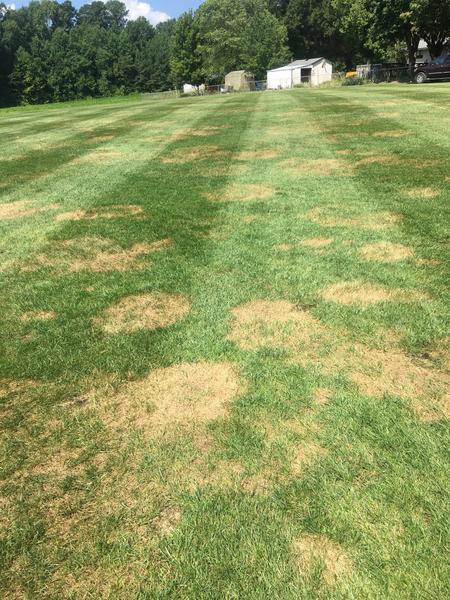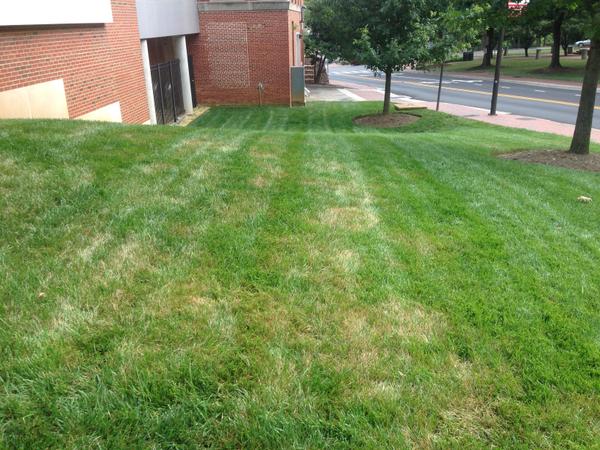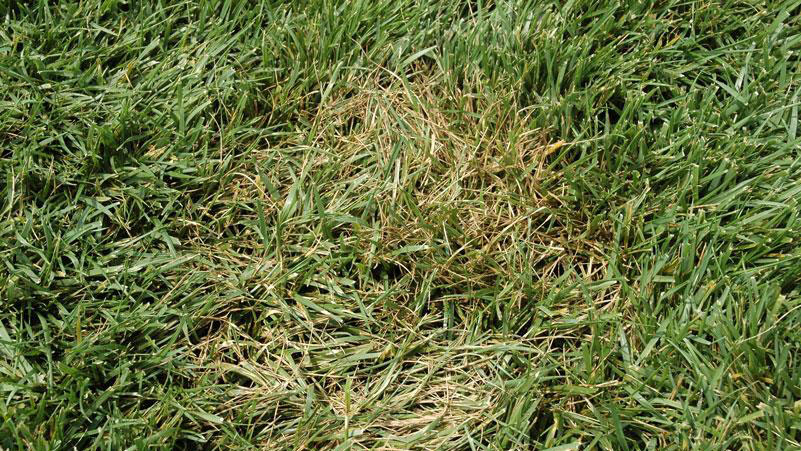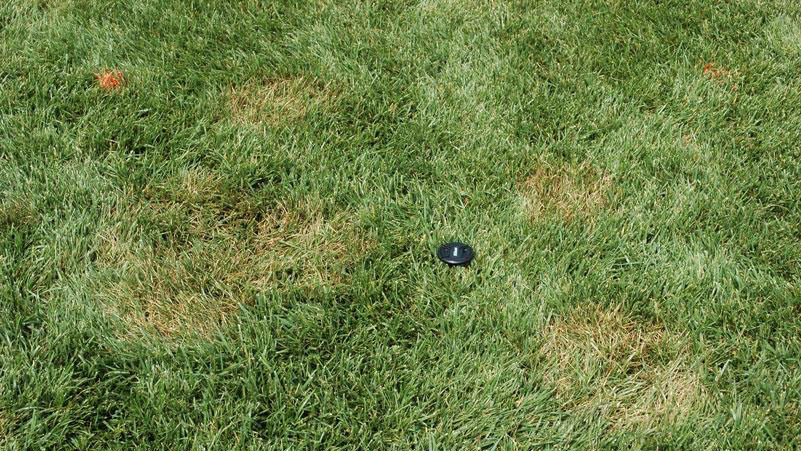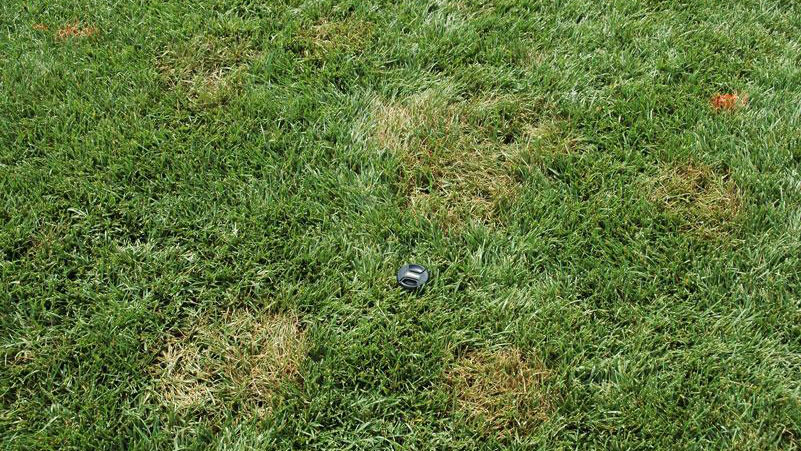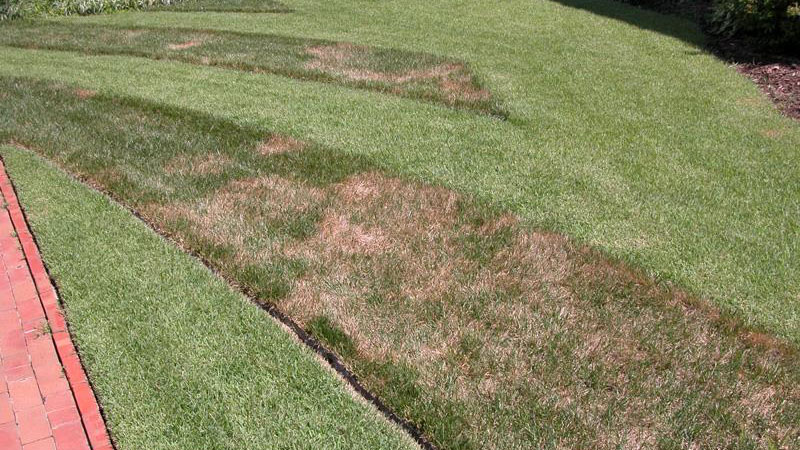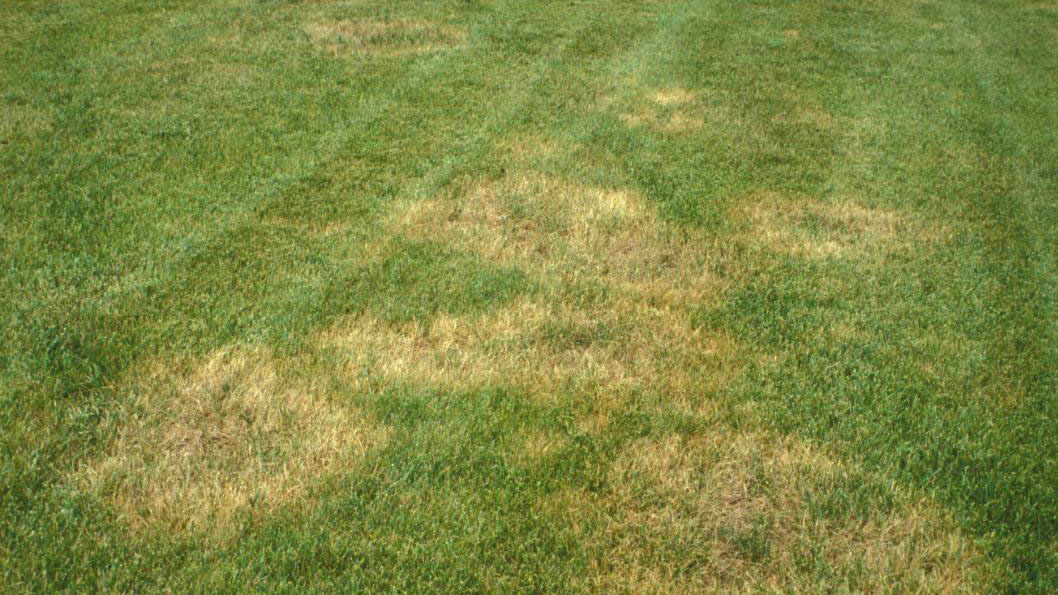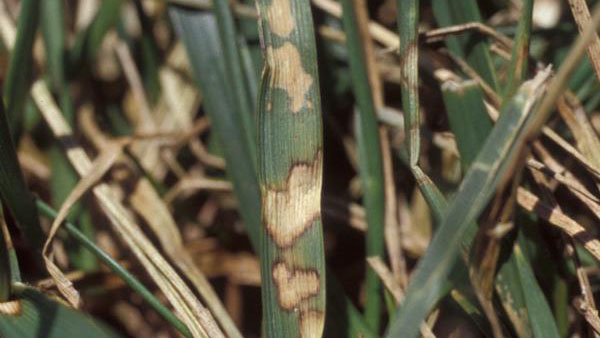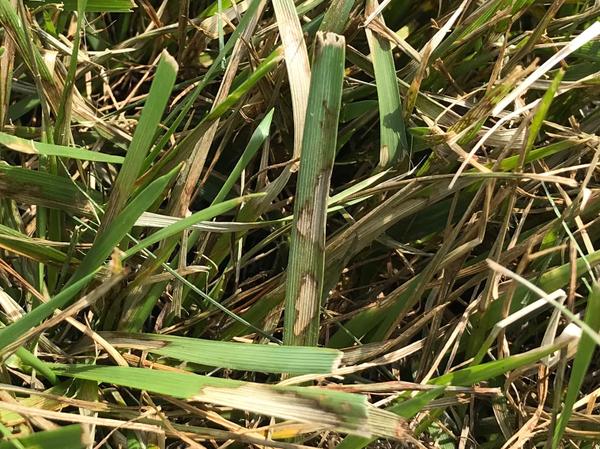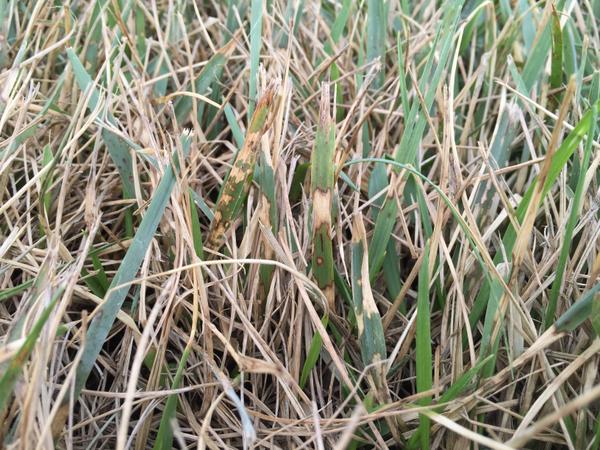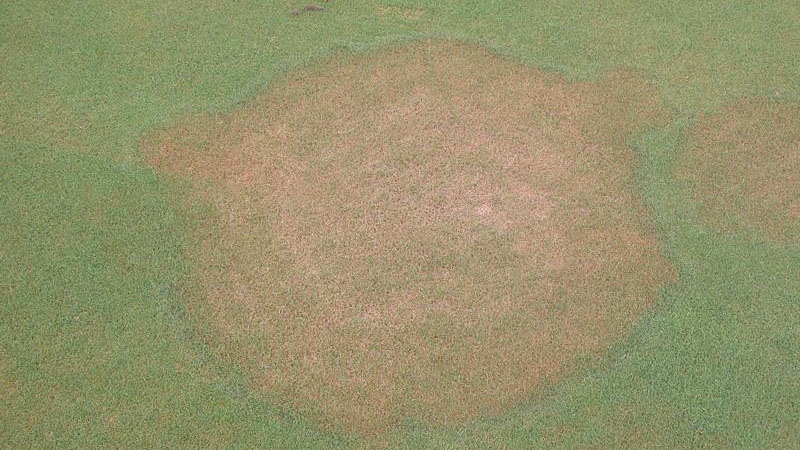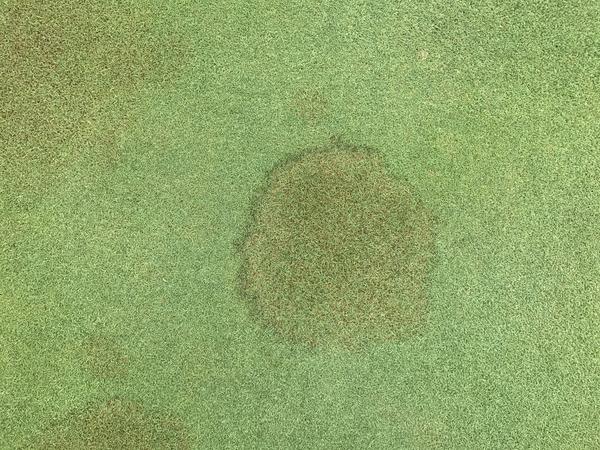Symptoms
The symptoms of brown patch vary according to mowing height. In landscape situations, where mowing height is greater than 1 inch, brown patch appears as roughly circular patches that are brown, tan, or yellow in color and range from 6 inches to several feet in diameter. The affected leaves typically remain upright, and lesions are evident on the leaves that are tan and irregular in shape with a dark brown border. When the leaves are wet or humidity is high, small amounts of gray cottony growth, called mycelium, may grow amongst affected leaves. In close-cut turfgrasses (1 inch or less), brown patch develops in roughly circular patches, ranging from a few inches to several feet in diameter, that are brown or orange. Distinct foliar lesions are not visible, and mycelium is typically absent, but a black or dark gray ring, called a smoke ring, may surround the brown patches. The smoke ring is evidence of active disease development and is only present when the turfgrass leaves are wet, or the humidity is near 100%.
Development Factors
Brown patch is most severe during extended periods of hot, humid weather. The disease can develop when night temperatures exceed 60°F but is most severe when low and high temperatures are above 70°F and 90°F, respectively. The turfgrass leaves must be continuously wet for at least 10 to 12 hours for the brown patch fungus to infect. Poor soil drainage, lack of air movement, shade, cloudy weather, dew, over-watering, and watering in late afternoon favor prolonged leaf wetness and increased disease severity. Brown patch is particularly severe in turf fertilized with excessive nitrogen. Inadequate levels of phosphorus and potassium also contribute to injury from this disease.
Cultural Control
Varieties of tall fescue vary widely in their susceptibility to brown patch. Selection of a tall fescue variety with a high level of brown patch resistance is a critical first step in any management program. There are few differences in brown patch resistance among varieties of bluegrass, ryegrass, or bentgrass.
Do not apply more than 0.5 lb nitrogen/1,000 square feet when conditions favor disease development. In general, cool-season grasses should not receive more than 1 lb nitrogen/1,000 square feet at any one time. Nitrogen applications in late spring or summer at 0.5 lb N / 1,000 square feet or less does not increase brown patch severity. Ensure adequate amounts of potassium and phosphorus by applying these nutrients based on soil test results.
Avoiding prolonged periods of leaf wetness will drastically reduce the severity of brown patch. Leaf wetness can originate from irrigation, dew, or guttation (which is the water that is sometimes exuded from turfgrass leaves during the night). To minimize leaf wetness, do not irrigate daily. Instead, irrigation should be applied based on weather conditions and the water requirements of the turf. The time of day that irrigation is applied is also critical; it is best to irrigate early in the morning, just before sunrise. This removes large droplets of dew and water from the leaves and speeds drying of the foliage after sunrise. Avoid watering after sunrise or in the late afternoon or evening, as this will increase the duration of leaf wetness. In golf course turf, daily removal of morning dew can help to shorten leaf wetness periods and reduce brown patch development. This can be accomplished by mowing, dragging a hose, or by whipping the greens with a bamboo or fiberglass pole.
Proper landscape design and site preparation can help to minimize brown patch problems. Turf surrounded by trees, shrubs, buildings, or other barriers will remain wet for extended periods of time due to reduced air movement and sunlight. Removal or pruning of trees and other barriers will help minimize leaf wetness and discourage brown patch development. In shady areas, plant turfgrass species that are tolerant of low light levels, such as hard fescue, chewings fescue, or strong creeping red fescue..
Good surface and soil drainage will also help reduce the incidence of brown patch. Avoid establishing turf in low areas that collect water or in soil that is heavily compacted. Aerate high-traffic areas each fall to reduce compaction and maintain soil drainage. Golf course putting greens should be cultivated regularly to maintain soil drainage and aeration.
Chemical Control
Fungicides are effective for brown patch control, and can be applied on a preventative or curative basis. Curative applications may not be effective during periods of hot weather because the cool-season grasses are growing slowly and are unable to recover from the damage under these conditions. Consider a preventive fungicide program for tall fescue and creeping bentgrass when conditions favor disease development. For best results, preventative applications should be initiated in the late spring or early summer when night temperatures consistently exceed 60°F.
* Products marked with an asterisk are not labeled for home lawn use.
| Fungicide and Formulation1 | Amount of Formulation2 | Application Interval (Days)3 | Efficacy Rating | Resistance Risk | FRAC Code4 |
| azoxystrobin (Heritage) WG TL G |
0.2 to 0.4 1 to 2 2 to 4 lbs |
14 to 28 14 to 28 14 to 28 |
++++ | Low | 11 |
| azoxystrobin + acibenzolar-S-methyl (Heritage Action)* | 0.2 to 0.4 | 14 to 28 | ++++ | Low | 11/P01 |
| azoxystrobin + chlorothalonil (Renown)* | 2.5 4.5 |
14 14 to 21 |
++++ | Low | 11/M5 |
| azoxystrobin + difenoconazole (Briskway)* | 0.5 to 1.2 | 14 to 28 | ++++ | Low | 11/3 |
| azoxystrobin + propiconazole (Headway) EC G |
0.75 to 3 2 to 4 lbs |
14 to 28 14 to 28 |
++++ | Low | 11/3 |
| azoxystrobin + propiconazole (Compendium) | 0.65 to 1.3 | 14 | ++++ | Low | 11/3 |
| azoxystrobin + tebuconazole (Strobe T)* | 0.75 to 1.5 | 14 to 21 | ++++ | Low | 11/3 |
|
benzovindiflupyr + difenoconazole (Ascernity)* |
1.0 | 14 to 21 | ++++ | Low | 7/3 |
|
boscalid + chlorothalonil (Encartis)* |
3 to 4 | 14 | +++ | Low | 7/M5 |
|
chlorothalonil (Daconil Ultrex)* |
1.8 to 3.25 |
7 to 14 |
+++ | Low | M5 |
| chlorothalonil (Daconil Weather Stik)* | 2 to 3.6 4 to 5.5 |
7 to 14 14 |
+++ | Low | M5 |
| chlorothalonil (Daconil Zn)* | 3 to 5 6 to 8 |
7 to 14 14 |
+++ | Low | M5 |
| chlorothalonil + acibenzolar-S-methyl (Daconil Action)* | 2 to 3.5 4 to 5.4 |
7 to 14 14 |
+++ | Low | M5/P01 |
| chlorothalonil + fluoxastrobin (Fame C)* | 1.5 to 5.9 | 14 to 28 | ++++ | Low | M5/11 |
| chlorothalonil + iprodione + thiophanate-methyl + tebuconazole (Enclave)* | 3 to 4 7 to 8 |
14 to 21 28 |
++++ | Low | M5/2/1/3 |
| chlorothalonil + propiconazole (Concert II)* | 3 to 8.5 | 14 to 28 | +++ | Low | M5/3 |
| chlorothalonil + propiconazole + fludioxonil (Instrata)* | 2.75 to 6 | 14 to 21 | +++ | Low | M5/3/12 |
| chlorothalonil + thiophanate-methyl (Spectro)* |
3 to 5.76 |
7 to 14 |
+++ | Low | M5/1 |
|
cyazofamid + azoxystrobin (Union) |
2.9 to 5.75 | 14 to 28 | ++++ | Low | 21/11 |
| fluazinam (Secure)* | 0.5 | 14 | ++ | Low | 29 |
| fluazinam + acibenzolar-S-methyl (Secure Action)* | 0.5 | 14 | ++ | Low | 29/P01 |
| fluazinam + tebuconazole (Traction)* | 1.3 | 14 | +++ | Low | 29/3 |
| fludioxonil (Medallion) | 0.75 to 2 | 7 to 14 | +++ | Low | 12 |
|
fluindapyr + flutriafol (Kalida) |
0.25 to 0.4 | 14 to 28 | ++++ | Low | 7/3 |
| fluopyram + trifloxystrobin (Exteris Stressgard) | 2.1 to 6 | 14 to 28 | +++ | Low | 7/11 |
| fluoxastrobin (Fame) | 0.1 to 0.4 | 14 to 28 | ++++ | Low | 11 |
| fluoxastrobin + tebuconazole (Fame T)* | 0.45 to 0.9 | 21 to 28 | ++++ | Low | 11/3 |
| fluxapyroxad (Xzemplar) | 0.21 to 0.26 | 14 to 21 | +++ | Low | 7 |
| flutolanil (Prostar) (Pedigree) |
1.5 to 3 2.2 to 4.4 |
14 to 21 14 to 21 |
++++ ++++ |
Low Low |
7 |
| flutolanil + thiophanate-methyl (SysStar) | 2 to 3 | 14 to 21 | ++++ | Low | 7/1 |
| flutriafol (Rayora)* | 0.7 to 1.4 | 14 to 21 | ++++ | Low | 3 |
| iprodione (26GT)* | 3 to 4 | 14 to 28 | +++ | Low | 2 |
| iprodione + thiophanate-methyl (26/36)* | 1 to 4 | 14 | +++ | Low | 2/1 |
| iprodione + trifloxystrobin (Interface Stressgard)* | 3 to 5 | refer to label | ++++ | Low | 2/11 |
| isofetamid + tebuconazole (Tekken)* | 3 | 14 to 28 | +++ | Low | 7/3 |
| mancozeb* (Fore) (Dithane) |
4 4 |
10 10 |
++ | Low | M3 |
| mandestrobin (Pinpoint) | 0.31 | 14 | + | Low | 11 |
| mefentrifluconazole + pyraclostrobin (Navicon)* | 0.7 to 0.85 | 14 to 28 | ++++ | Low | 3/11 |
| metconazole (Tourney) | 0.28 to 0.37 | 14 to 21 | ++ | Low | 3 |
| mineral oil (Civitas Turf Defense)* | 8.5 to 17 | 14 to 21 | + | Low | -- |
| myclobutanil (Eagle) | 1.2 | 14 | + | Low | 3 |
| penthiopyrad (Velista) | 0.3 to 0.5 | 14 to 21 | ++ | Low | 7 |
| polyoxin D (Affirm) (Endorse) |
0.88 4 |
7 to 14 7 to 14 |
+++ | Low | 19 |
| propiconazole (Banner MAXX II) | 1 to 2 | 14 to 21 | ++ | Low | 3 |
|
prothioconazole (Densicor)* |
0.196 | 14 to 21 | ++++ | Low | 3 |
|
Pseudomonas chlororaphis strain AFS009 (Zio) |
1.8 to 6 | 7 to 21 | ++ | Not Known | BM02 |
|
pydiflumetofen + azoxystrobin + propiconazole (Posterity Forte)* |
0.63 to 0.84 | 14 to 21 | ++++ | Low | 7/11/3 |
|
pydiflumetofen + azoxystrobin + propiconazole (Posterity XT)* |
0.75 to 3 | 14 to 28 | ++++ | Low | 7/11/3 |
| pyraclostrobin (Insignia) WG SC |
0.5 to 0.9 0.4 to 0.7 |
14 to 28 14 to 28 |
++++ | Low | 11 |
| pyraclostrobin + boscalid (Honor)* | 0.55 to 1.1 | 14 to 28 | ++++ | Low | 11/7 |
| pyraclostrobin + fluxapyroxad (Lexicon Intrinsic) | 0.34 to 0.47 | 14 to 28 | ++++ | Low | 11/7 |
| pyraclostrobin + triticonazole (Pillar G) | 3 lbs | 14 to 28 | +++ | Low | 11/3 |
| tebuconazole (Torque)* (Mirage Stressgard)* |
0.6 to 1.1 1 to 2 |
21 14 to 28 |
+++ | Low | 3 |
| triadimefon (Bayleton) | 0.5 to 1 | 15 to 30 | ++ | Low | 3 |
| trifloxystrobin (Compass) | 0.1 to 0.2 0.15 to 0.25 |
14 21 |
+++ | Low | 11 |
| trifloxystrobin + triadimefon (Armada) (Tartan)* |
0.6 to 1.5 1 to 2 |
14 to 28 14 to 28 |
+++ | Low | 11/3 |
| triticonazole (Trinity) (Triton Flo) |
0.75 to 2 0.41 to 1.1 |
14 to 28 14 to 28 |
++ | Low | 3 |
| 1 Other trade names with the same active ingredients are labeled for use on turfgrasses and can be used according to label directions. 2 Units are oz, fl oz, or lb depending on formulation. Apply fungicides in 2 to 5 gallons of water per 1,000 square feet according to label directions. Use lower rates for preventive and higher rates for curative applications. 3 Use shorter intervals when conditions are very favorable for disease. 4 Fungicide Resistance Action Committee code. Products with same code have the same mode of action and are in the same chemical class. * Products marked with an asterisk are not labeled for home lawn use. |
|||||
| Efficacy Rating ++++ = excellent control when conditions are highly favorable for disease development +++ = good control when disease pressure is high, excellent control when disease pressure is moderate ++ = good control when disease pressure is moderate, excellent control when disease pressure is low + = good control when disease pressure is low ? = not rated due to insufficient data |
|||||
| Resistance Risk Low = Rotate to different chemical class after 3-4 applications; tank mixing not necessary Medium = Rotate to different chemical class after 1-2 applications; tank-mixing with low or medium risk product recommended High = Rotate to different chemical class after EVERY application; tank-mix with low or medium risk product for EVERY application ? = not rated due to insufficient data |
|||||
Species Data
- HOST SPECIES
- bentgrass, bluegrasses, fescues, ryegrasses
- MONTHS WITH SYMPTOMS
- May to September
- STAND SYMPTOMS
- patches (4 inches to greater than 3 feet)
- FOLIAR SYMPTOMS LOCATION / SHAPE
- leaf lesions
- FOLIAR SYMPTOMS COLOR
- tan, brown, or yellow
- ROOT / CROWN SYMPTOMS
- none
- FUNGAL SIGNS
- mycelium or none
Publication date: Nov. 14, 2017
Reviewed/Revised: Dec. 16, 2019
Recommendations for the use of agricultural chemicals are included in this publication as a convenience to the reader. The use of brand names and any mention or listing of commercial products or services in this publication does not imply endorsement by NC State University or N.C. A&T State University nor discrimination against similar products or services not mentioned. Individuals who use agricultural chemicals are responsible for ensuring that the intended use complies with current regulations and conforms to the product label. Be sure to obtain current information about usage regulations and examine a current product label before applying any chemical. For assistance, contact your local N.C. Cooperative Extension county center.
N.C. Cooperative Extension prohibits discrimination and harassment regardless of age, color, disability, family and marital status, gender identity, national origin, political beliefs, race, religion, sex (including pregnancy), sexual orientation and veteran status.

